mobile View, to the German Version tap the flag


- Republic of Cameroon
- authoritarian presidial republic with multi-party-system
- own names:
- English: Republic of Cameroon
- French: République du Cameroun
• Flag
• Historical Flags
• Meaning/Origin of the Flag
• Coat of Arms
• Meaning/Origin of the Coat of Arms
• Aircraft Roundel
• Map
• Numbers and Facts
• History
• Origin of the Country's Name
• Sothern Cameroons (Ambazonia)
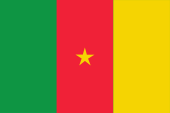
National flag,
ratio = 2:3,
Source, by: Corel Draw 4






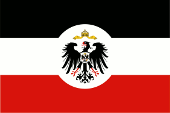
1893–1916,
Official flag of Colonial Office,
ratio = 2:3,
Source, by:
Wikipedia (DE)





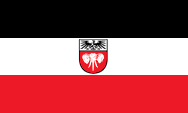
1914,
planned flag for German Cameroon,
ratio = 3:5,
Source, by:
Flags of the World,
Flag Reconstruction following Mark Sensen (Feb 98)
based on traditional interpretation from Afrika-Nachrichten article 1933



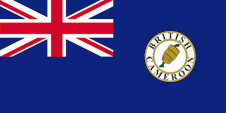
1919–1961,
Flag of the government (state flag) of British Cameroon,
ratio = 1:2,
Source, by:
Wikipedia (DE)



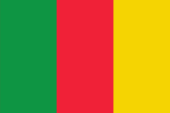
1957–1961,
National flag of French Cameroon,
ratio = 2:3,
Source, by:
Wikipedia (DE)



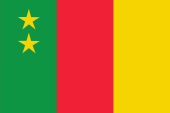
1961–1975,
National flag, Federal Republic of Cameroon
ratio = 2:3,
Source, by:
Wikipedia (DE)




The today's flag was officially hoisted on 20th of May in 1975. It is a alteration of the hitherto valid flag and shows as well the by model of the French tricolor arranged colours green, red and yellow. In the middle of the red middle stripe is situated a yellow five-pointed star. In the flag of Cameroon stands green for wood riches and the hope for a lucky future, yellow stands for the savannas and red for the independence. The star symbolizes the national unity. The combination of the colours green, yellow and red are the pan-african colours: Perhaps in 1900 was the beginning of the Panafrica-Movement, wich wants to emphasize the commons of all people with black skin. For the political unity of Africa stands the colour-triad green-yellow-red, wich used many african countries in their flags after the independence. The first country was Ghana in 1957. As the origin apply the colours of Ethiopia (Abessinia), the oldest independent state in Africa. The colour triad of green, yellow and red, which is widely used internationally, does not seem to be binding in terms of colour, not even for Cameroon itself. The following colour values for the colour triad are known, they are deposited with the International Olympic Committee (IOC): Green = Pantone 355, Red = Pantone 032, Yellow = Pantone 109. As a German colony, the country did not use an own or special flag. There were used the colors of the German Empire: black, white and red. Authorities used the flag of the Colonial Office as well as varieties of it. That was black, white and red horizontally striped and showed in the middle of it a white disc with the imperial eagle. From 1913 it was considered to create own emblems for the colonies. First drafts were made in 1914, but the project was not realized because of the outbreak of the First World War and because of the loss of the colonies.
Source:
Die Welt der Flaggen,
Flaggen Wappen Hymnen,
Wikipedia (DE),
Flags of the World


1914,
planned coat of arms of German Cameroon,
Source, by: Flags of the World, Flag Reconstruction following Mark Sensen (Feb 98) based on traditional interpretation from Afrika-Nachrichten article 1933

1960–1961,
Coat of arms of Cameroon,
Source, by: Wikipedia (FR), basing on Corel Draw 4

1961–1972,
Coat of arms of Cameroon,
Source, by: Wikipedia (FR), basing on Corel Draw 4

1972–1984,
Coat of arms of Cameroon,
Source, by: Wikipedia (FR), basing on Corel Draw 4

since 1984,
Coat of arms of Cameroon,
Source, by: Wikipedia (FR), basing on Corel Draw 4

On the occasion of the independence was adoped a coat of arms which pictured a by a red angle splited shield in green and gold. On the red angle the blue map of Cameroon, a black sword and the pans of justice. In the upper parts of the green and golden fields was one five-pointed blue star. On the reverse of the shield were two crossing golden Liktor's bundles. The motto ribbon above the blazon showed the name of the country in French language and the datum of the independence, the motto ribbon below the blazon in French language the motto: "Paix, Travail, Patrie" → "Peace, Work, Fatherland ". The today's coat of arms was several times changed. In this way was in 1975 removed the blue star from the green field. In 1984 was even removed the blue star from the golden field, but added a golden star into the green field. Moreover was deleted the datum of independence. The today's coat of arms of Cameroon was created in 1986. It is again a change of the hitherto valid model and showes now the golden star on the top of the red field. The motto ribbon below the blazon shows an other style and the name of the country in French and now even in English language. The motto of the country is likewise bilingual grouped in a semicircle above the blazon: "Paix, Travail, Patrie" → "Peace, Work, Fatherland". The country was once a German colony. The German colonies – except Kiaochow – had been subordinated under the Imperial Colonial Office. Accordingly, public authorities used its seals, flags, and the Imperial coat of arms. From 1913 it was considered to create own emblems for the colonies. First drafts were made in 1914, but the project was not realized because of the outbreak of the First World War and because of the loss of the colonies. The imaginary appearance of the coats of arms and flags could only be reconstructed on the basis of fragments in the 20s and 30s of the 20th century. Most of the reconstructions refer to an article in the newspaper "Afrika-Nachrichten" from 1933 and the subsequent reconstructions of the Dutch vexillologist Mark Sensen from February 1998, which are also taken into account on these pages. The coats of arms themselves should additionally show the imperial crown above the escutcheon, but not on the flags, following the reconstruction of Mark Sensen. The escutcheons always showed the same structure: A horizontally twofold splited shield, the head of the shield showed the imperial eagle on white ground with the escutcheon of the House of Hohenzollern on the chest. In the main part appeared a stylized representation of plants, animals or landscapes, which were colored differently depending on the country. The planned coat of arms of Cameroon showed a white elephant head on a red background.
Source:
Wikipedia (D),
Die Welt der Flaggen,
Flaggen und Coat of arms of the Welt,
Mark Sensen

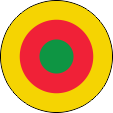
Aircraft Roundel,
Source, by: Wikipedia (EN)

Location:
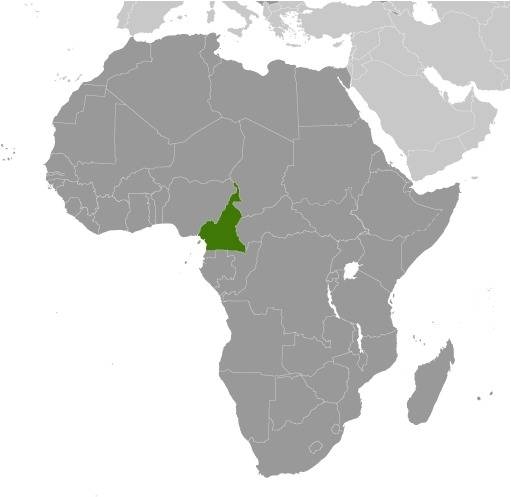
Source: CIA World Factbook
Map of the country:
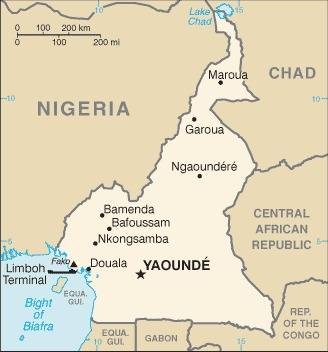
Source: CIA World Factbook
Cameroon from 1884 until today:
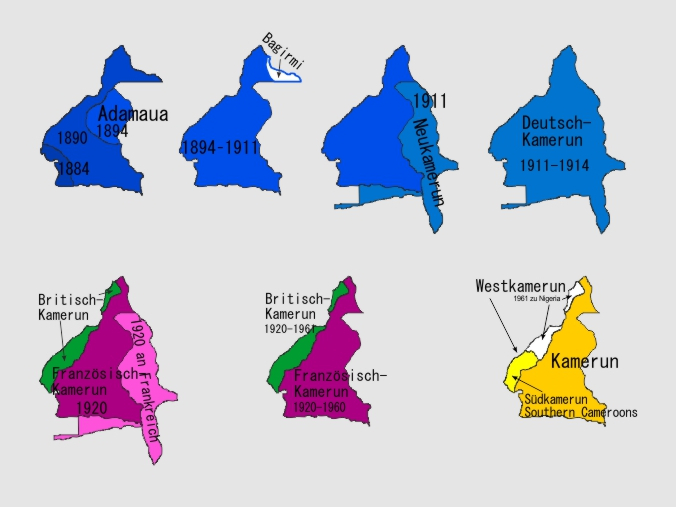
Quelle/Source: Volker Preuß

Area: 183.568 square miles
Inhabitants: 28.524.000 (2021), thereof 24.3 % Bamileke-Bamu, 21.6 % Beti/Bassa and Mbam, 14.6 % Biu-Mandara, 11 % Arab-Choa/Hausa/Kanuri, 9.8 % Adamawa-Ubangi, 7.7 % Grassfields, 3.3 % Kako and Meka/Pygmy, 2.7 % Cotier/Ngoe/Oroko, 0.7 % Southwestern Bantu, 4.5 % foreign/other ethnic group, less than 1% non-African, among them 6.000 French, 500 Germans
Religions: 38% Roman Catholic, 26% Protestant, 20% Muslim, 5% Animist, 3% Non-Religious
Density of Population: 155 inh./sq.mi.
Capital: Yaoundé (Jaunde), 1.926.500 inh. (2019)
official Languages: English, French
other Languages: Bantu languages, Fulbe languages, German
Currency: CFA-Franc (BEAC) = 100 Centimes, FCFA = "Franc de la Coopération Financière en Afrique Centrale"
Time Zone: GMT + 1 h
Source:
Wikipedia (D),
CIA World Factbook,
Deutsche im Ausland

1482 · the Portugese Diego Cão discovers the coast of the today's Cameroon
15. cent. to 1893 · the north of the today's Cameroon belongs until the end of the 19th cent. to the State of Bornu
17. cent. · Cameroon gets its name after the Crab River (Rio de Camarões)
1810 · in the middle of the today's Cameroon rises a Emirate of Adamaua
1868 · first German factory in Cameroon
1884 · Gustav Nachtigal (1834–1885) annexes the coast of Cameroon for the German Empire, establishment of the Colony of Cameroon
1885 · frontier treaties with United Kingdom in the north and France in the south as well as military campaigns extend the area of the colony
1894 · the Emirate of Adamaua is annexed by the Colony of Cameroon, Cameroon achieves approximately its today's dimension
1911 · the German Empire waives the Bagirmi Region in the north and receives from France important areas in the east and south
1914–1918 · First World War
1916 · the German troops (Schutztruppe) in Cameroon surrender partly, the country is occupied by the British and French, a small part of the Schutztruppe crosses the border to neutral Spanish territory in Spanish Guinea/Rio Muni, and is interned there until the end of the war
1920 · the territorial gains from 1911 are conscripted by France, the Versailles Dictate splits the residual Cameroon officially into a French (Eastern Cameroon, 166.795 sq.mi.) and a British mandate (Western Cameroon 34.093 sq.mi.) of the League of Nations, the British zone is administered from Nigeria
1947 · foundation of the UPC (Union des Populations de Cameroun), claim for reunification and independence
1955 · the UPC starts the armed struggle, guerilla war until 1965
1958 · France grants Eastern Cameroon autonomy in the framework of the French Community
1st of January 1960 · independence for Eastern Cameroon
1st of October 1961 · the south of British Cameroon (Western Cameroon) unites after a plebiscite with Eastern Cameroon to the Federal Republic of Cameroon, the north of Western Cameroon gets annexed to the since 1st of October 1960 independent Nigeria
1972 · new constitution, the federalistic system gets abolished, proclamation of the United Republic of Cameroon
1993 · frontier quarrels with Nigeria
1994 · ethnic riotings
1993 · once more frontier quarrels with Nigeria
1999 · riotings between the English speaking and the French speaking population, separatists proclaim the English speaking Federal Republic of South Cameroon (Ambazonia)
2000 · election of a president in South Cameroon (Ambazonia)
Source:
Atlas zur Geschichte,
Wikipedia (D)

The name of the country goes back to the Portuguese, when they came with their ships into the inlets of the Wouri Estuary and they found many crabs (Camarões). So they called the whole river "crab river " (Rio de Camarões). This name was transferred to the entire area in the hinterland of the estuary bay in the 16th century.
Source:
Handbuch der geographischen Namen

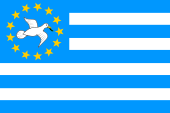
since 2001,
National flag,
ratio = 2:3,
Source, by:
Wikipedia (DE),
Flags of the World



Since about the year 2000, the "Southern Cameroon People's Organization" tries to separate the English speaking West of Cameroon as the Republic of Ambazonia from the rest of the country. The associated violence reached a climax in 2018.
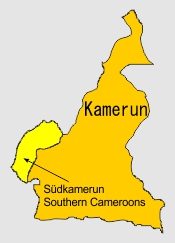


![]()































